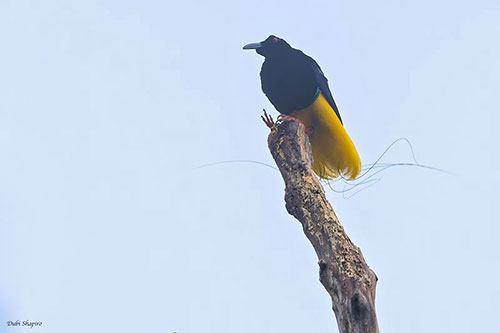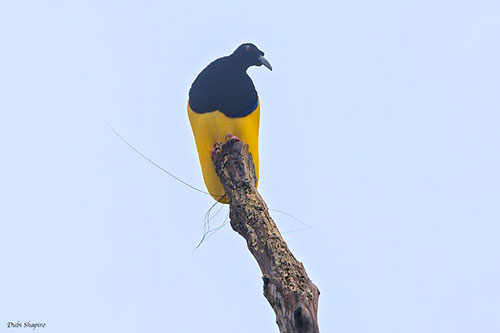
PROTECTION / THREATS / STATUS:
The Twelve-wired Bird-of-paradise is described as locally uncommon to common. It has extensive range and habitat.
The size of the population is unknown, but it is suspected to be declining. Habitat loss and high hunting pressure are the main threats for this species.
However, the Twelve-wired Bird-of-paradise is not globally threatened and the species is currently evaluated as Least Concern.
Fr: Paradisier multifil
Ang: Twelve-wired Bird-of-paradise
All: Fadenparadiesvogel
Esp: Ave del Paraíso Filamentosa
Ita: Uccello del paradiso dodici fili
Nd: Twaalfdradige Paradijshop
Sd: tolvtrådig paradisfågel
Photographers:
Otto Plantema
Trips around the world
Dubi Shapiro
Dubi Shapiro Photo Galleries
Text by Nicole Bouglouan
Sources:
HANDBOOK OF THE BIRDS OF THE WORLD Vol 14 by Josep del Hoyo-Andrew Elliot-David Christie - Lynx Edicions – ISBN: 9788496553507
Les Oiseaux de paradis – Histoire Naturelle et photographies - par Michel Ottaviani - Editions Prin, France – ISBN : 2-909136-40-X
Birds of Paradise and Bowerbirds De Phil Gregory – Editeur: Bloomsbury Publishing, 2020 – ISBN: 1472975847, 9781472975843 – 416 pages
Birds of New Guinea: Second Edition De Thane K. Pratt, Bruce M. Beehler – Editeur: Princeton University Press, 2014 – ISBN: 0691095639, 9780691095639 – 528 pages
Birds of New Guinea: Distribution, Taxonomy, and Systematics De Bruce M. Beehler, Thane K. Pratt – Editeur: Princeton University Press, 2016 – ISBN: 069116424X, 9780691164243 – 672 pages
Book of Curious Birds De Jennifer Cossins – Editeur: Hachette UK, 2021 – ISBN: 073442048X, 9780734420480 – 64 pages
Astonishing Animals: Extraordinary Creatures and the Fantastic Worlds They ... De Tim Flannery – Editeur: Open Road + Grove/Atlantic, 2012 – ISBN: 0802194176, 9780802194176 – 192 pages
Bird: The Definitive Visual Guide De DK – Editeur: Dorling Kindersley Ltd, 2022 – ISBN: 0241596319, 9780241596319 – 512 pages
Courtship and Mating Behaviour of the Twelve-wired Bird of Paradise Seleucidis melanoleuca
Twelve-wired Bird-of-Paradise: What Are the Wires For? | Cornell / National Geographic
BREEDING THE TWELVE-WIRED BIRD OF PARADISE
Animals in South-East Asia
Meet The Unique Twelve-Wired Bird-Of-Paradise
CREAGUS@Monterey Bay (Don Roberson)
Fatbirder - The World’s Richest Information Resource about Birds for Birders
Wikipedia, the free encyclopaedia
Twelve-wired bird-of-paradise
Seleucidis melanoleucus
Passeriformes Order – Paradisaeidae Family
INTRODUCTION:
The Twelve-wired Bird-of-paradise is a monotypic species found in lowland forests in New Guinea (except NE and far E) and Salawati Island in West Papua.
It frequents swampy forests and flat lowlands where it feeds on fruits, nectar, insects, arthropods and frogs.
The brightly-coloured male is polygynous. It displays from traditional perches, dancing to attract a female and brushing her with the long wiry feathers protruding from the yellow rump, while swaying from side to side. The female alone builds and attends the nest.
The Twelve-wired Bird-of-paradise is described as uncommon to common, but the population is declining due to habitat loss and hunting pressure. But currently, the species is not globally threatened.
DESCRIPTION OF THE BIRD:
Biometrics:
Length: M: 33 cm – F: 35 cm
Weight: M: 170-217 g – F: 160-188 g
The Twelve-wired Bird-of-paradise adult male has velvet black and yellow plumage, but other iridescent colours may appear depending on the light. The male needs five to seven years to develop its wonderful plumage.
The upperparts (including the lesser coverts) are velvet black with coppery olive-green sheen, and in some lights, with purple wash.
The greater coverts, alula, tertials, secondaries and the uppertail are iridescent violet-purple and /or magenta. The primaries are black.
On the underparts, chin, throat and breast are velvety black with some coppery, yellowish-green iridescent sheen. The lower breast is bordered with large feathers showing broad, iridescent emerald-green tips and violet adjacent bases. This pattern forms a gorget extending up on each side of the breast. An extensive “cushion” is formed by the elongate and dense breast feathers which are fluffed out during the displays.
Rest of underparts include elongated, bright yellow, filamentous flank feathers that curve inwards. On each side of the flanks, six plumes are grossly elongated beyond the webs into black wires. These plumes become white again after recurving upwards. Those twelve special plumes give the bird its name.
The head is entirely velvety black with coppery olive-green sheen, whereas the crown shows purple iridescence.
The long, slightly decurved bill is black. The mouth is yellowish-green. The eyes are bright red with a black stripe of bare skin on the rear eye. Thighs, legs and feet are pink.

The adult female is very different and smaller than male, but with longer tail. She has very cryptic plumage.
Upper head and upper mantle are sooty black with dull purple sheen. Lower mantle and rest of upperparts are chestnut-brown, but paler on primaries.
On the underparts, malar area, throat and upper breast are whitish with flecks and spots, and then uniformly barred blackish like the remaining underparts. The bare parts are like in male.
The juvenile is not described.
The immature male resembles adult female but it has longer tail. The plumage may be paler and washed pale orange-yellow, and the lower mandible has brown base. The eyes are pale brown, becoming yellow as the bird is growing.
The eyes change from yellow to almost red and the tail becomes shorter in subadult male.
RANGE:
The Twelve-wired Bird-of-paradise is found throughout New Guinea (except north-east and far east) and Salawati Island, Indonesia.
HABITAT:
The Twelve-wired Bird-of-paradise is found in swampy forest areas and flat lowlands where it forages. The species is usually present up to 180 metres of elevation, especially in swamp forest, permanently or seasonally flooded with plants of genera Pandanus and Metroxylon.
CALLS AND SONGS: SOUNDS BY XENO-CANTO
The Twelve-wired Bird-of-paradise adult male is mainly heard during the courtship displays. It gives advertising calls while exposing the yellow feathers of the flanks. At this moment, we can hear a nasal, mournful, downslurred “hahng” and also a series of 3-8 notes “hahr-haw haw haw”. The first note is high-pitched and followed by a short pause. The following notes are uttered in rapid succession.
As soon as female approaches, the male utters higher, whining “twang hahng-hahng-hahng-hahng-hahng” falling in pitch. We can also hear a typical series of “koi-hoi-hoi-hoi-hoi”.
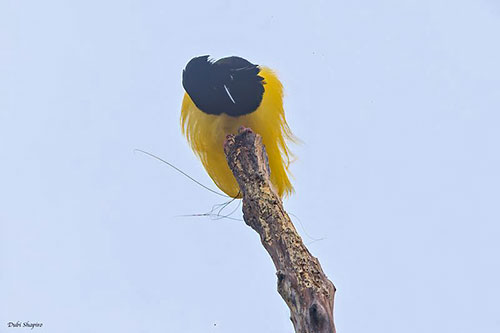
BEHAVIOUR IN THE WILD:
The Twelve-wired Bird-of-paradise feeds on fruits, insects, arthropods, frogs and nectar. The bird forages by hanging upside-down while probing holes in branches. It is very agile while searching for food.
It may sometimes join mixed-species foraging flocks.
The courtship displays of the Paradisaeidae are often spectacular. During the displays, the long wiry feathers play an important role.
The male is highly territorial, always making sure it is at least 700 metres away from the other males of the area. The perch is also defended against rivals.
The displays take place on a leafless tree stump well visible over the vegetation. The breast feathers are regularly flared while the male dances around the perch. The yellow lower body plumage is divided into two halves of six wires dangling from each side. The pink thighs are also exposed.
When a female approaches, the male climbs the display pole and brushes her with these wiry feathers. But sometimes, the wires can be caught in the female’s mouth when she probes her bill into the dense yellow feathers of her partner. However, the male usually continues the swaying dance, hopping from foot to foot while the female removes them.
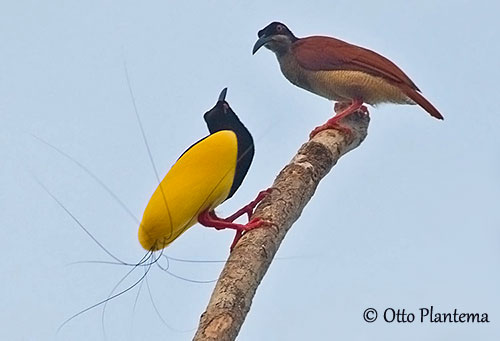
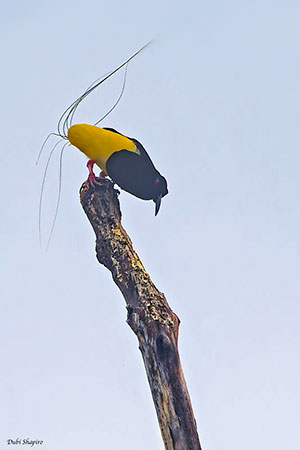
The copulation may occur after a short pursuit or movements up and down the perch, with or without one or more “Wire-wipe Displays”. Following the courtship displays and the copulation, the female builds the nest and performs alone the nesting duties
The Twelve-wired Bird-of-paradise is probably resident.
The flight is usually undulating, with wingbeats on spread, rounded wings interspersed with glides with the wings against the body sides. The “wires” are waving behind the bird during the flight.
REPRODUCTION OF THIS SPECIES:
The breeding season takes place from January to late October/early November in SE, near Port Moresby.
The nest is built by the female alone, mainly in Pandanus or Sago Palm, up to 14 metres above the ground. It is placed inside the bulky, deep structure of Pandanus bark and vines. A sparse foundation is made with sticks and leaves. Then, the cup is lined with softer material such as rootlets and plant fibres.
The female usually lays a single egg, rarely two. She incubates during about 20 days. The young leave the nest three weeks after hatching. It needs at least five years to gain the adult male plumage. The young are sexually mature at 4-6 years old.
